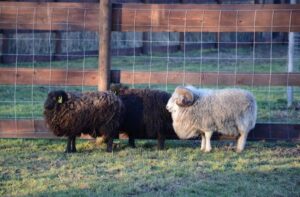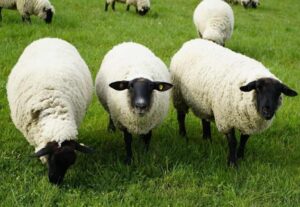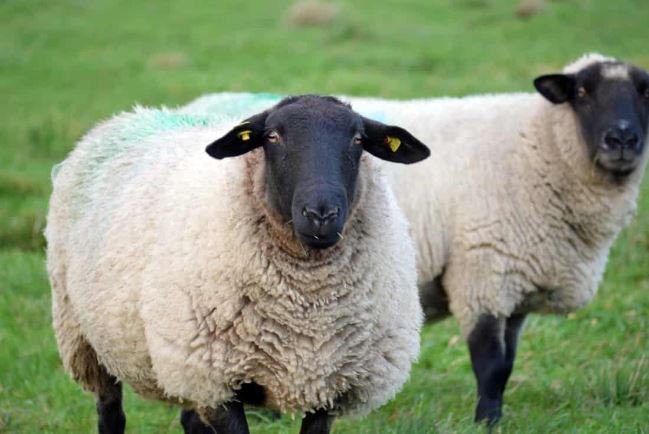Sheep Farm in Switzerland: Switzerland has a long tradition of sheep farming. It plays a significant role in Switzerland’s farming sector. One of the major producers of livestock in Europe is Switzerland, which has about 1.5 million sheep. Sheep need to be healthy and well-cared for in order to create wool of the highest quality. This includes supplying a wholesome food, clean water, a place to stay out of the elements, and routine health examinations.
How to establish a sheep farm in Switzerland
Is Swiss sheep herding profitable?
The profitability of sheep farming in Switzerland depends on a variety of variables. Two significant factors are the price of wool and the expense of land. You must take into account the effort and time needed to care for livestock. Sheep farming can be quite lucrative in Switzerland, provided that the cost of land and wool is favourable. Swiss wool is in high demand, and the country’s environment is ideal for growing sheep. Numerous goods, including clothing, carpets, and upholstery, use Swiss wool because of its reputation for high quality.
In order to stay productive and healthy, farmers must also handle the grazing pasture. One of the most significant agricultural sectors in Switzerland, where there are over 500,000 livestock, is the sheep industry. Sheep in Switzerland are primarily bred for their wool, which is used to create a variety of goods. Although the Alps are where the majority of Switzerland’s sheep are grown, the Swiss Plateau also has a large number of sheep farms.
Read More: How to Start Sheep Farming in Nigeria: Business Plan, Breeds, Cost, Profit and Management
Demand for organic and sustainable sheep herding methods has grown recently. Time and labour are major requirements for sheep farming. Farmers need to be ready to provide daily care for their herd, including feeding, watering, and exercising the sheep. Farmers also need to be familiar with lambing processes and shearing techniques. However, sheep farming can be a very rewarding endeavour if farmers are prepared to put in the time.

Zero grazing sheep farming in Switzerland
A method of raising sheep known as “zero grazing” is practised in Switzerland. In order to do this, the Sheep must be kept in a small space, like an enclosure or shed, and must be given all the food and water they require. Sheep farming’s primary advantage is that it lowers the possibility of diseases spreading from sheep to other animals. Additionally, it may promote the health of the sheep and raise the calibre of their fleece.
Sheep farming for beginners in Switzerland
1.In Switzerland, sheep farming is a well-known agricultural sector, and newcomers can find a wealth of resources to assist them in getting begun.
2. Choosing the type of sheep you want to raise is the first stage. There are numerous varieties of sheep, and each has particular traits. Find the breed that best fits your needs by doing some study.
3. You’ll need to purchase land to grow your Sheep once you’ve decided on your breed. You should make sure you have enough land for your flock because sheep need a lot of room to graze and roam. Additionally, you must construct a barn or other suitable refuge for your sheep.
4. The next step is to buy some animals. Beginners should generally start with baby lambs because they require less maintenance than mature sheep. Choose healthy animals from respected breeders when buying lambs.
5. Once you have a herd, it’s crucial to take good care of them. This entails giving them access to enough food, drink, and protection from the elements. Additionally, you’ll need to frequently check on your sheep for symptoms of illness or injury and take appropriate action. Sheep farming can be a rewarding endeavour with the right attention to detail and administration.
Tips for starting sheep farming in Switzerland
- Select the appropriate variety of sheep. Sheep come in a variety of varieties, each with unique traits. Find the breed that best suits your needs by doing your study.
- Obtain the necessary licences and permissions. A permit from the canton where you intend to store your sheep is required.
- Locate a suitable area for your property. Your farm’s location must offer your flock enough pasture space, access to water, and protection from the elements.
- Construct or buy the required fences and shelters. Make sure your property has enough shelters because your sheep will need somewhere to sleep and remain dry during inclement weather. To confine the sheep, you must also erect fences around your pastureland.
- Purchase or rent a herd of sheep. You can buy a flock of sheep once you have built all the required infrastructure. Prior to bringing any new animals into your herd, make sure they are in quarantine.
- Teach yourself and your staff the correct methods for caring for sheep. Success in sheep farming depends on taking good care of and managing your livestock. Prior to beginning, be sure you understand how to correctly care for your animals.
-
Organize a feeding schedule for your pastureland. It’s critical to create a grazing plan that rotates the animals among various pasture areas in order to keep healthy pastures.

Sheep farming areas in Switzerland
Switzerland has many regions where livestock are raised. Sheep farming works well in the Swiss Mountains. There are plenty of fields and valleys that are ideal for sheep farming. Switzerland has the ideal environment for sheep farming. Cattle can now be raised all year long thanks to this.Because of the country’s clean air and wholesome grasses, sheep flourish in Switzerland.
Since the Medieval Ages, sheep husbandry has been practised in Switzerland. In Switzerland, there are about 1.2 million sheep, accounting for about 4% of the nation’s overall livestock population. Most Swiss sheep are located in the country’s Alpine regions.
The majority of sheep in Switzerland are Merinos, a breed common in Europe. They generate high-quality wool and are well adapted to the Alpine temperature and terrain. Swiss sheep farmers place a strong emphasis on producing high-quality wool, which has several uses.
Switzerland’s sheep farming benefits
Sheep husbandry has several advantages, particularly in Switzerland. The environment is ideal for rearing sheep, and there are plenty of places to graze in the countryside. Sheep produce high-quality meat and wool, both of which are in high demand around the world. The best wool and meat products in the world are produced by Swiss sheep farmers thanks to these markets.
Also, sheep farming benefits the ecology. Grasslands are kept healthy and fruitful by sheep grazing there. Sheep manure is also a great all-natural fertiliser that may strengthen the soil.
Sheep farming types in Switzerland
1. Extensive sheep farming is a customary method of raising sheep, where the animals are allowed to forage freely on vast pastures. In many areas of Switzerland, particularly in the Alps, this style of sheep herding is still prevalent.
2.Intensive sheep farming is a more contemporary breed of sheep in which the animals are housed in smaller pastures and receive more supplemental feed. The lowlands of Switzerland are where this kind of livestock farming is more prevalent.
Which animals are found in Switzerland?
The Swiss White, European Brown, and Alpine sheep are the three major varieties found in Switzerland. The most prevalent breed of sheep in Switzerland is the Swiss White. It is a breed that is bred for both wool and meat, serving two purposes. Similar to the Swiss White, the European Brown is a dual-purpose type but is less prevalent. The Alpine is a breed of mountain dog that is mainly raised for meat. Other significant sheep varieties in Switzerland include Skudde and Schwarzbraunes Bergschaf.
Management of sheep grazing in Switzerland
Sheep are typically given hay, silage, and concentrates in Switzerland. Depending on the animal’s age, weight, and stage of development, the kind of feed and how much is provided to each sheep change. For roughage, sheep are usually given hay or silage. Cut and dried grass is made into hay, which is then spread out to cure. After that, it is kept and baled for use as feed during the winter. Silage is freshly cut grass that has been shut off from the air to keep it from spoiling.Additionally, sheep eat it as winter fodder.

High-energy feeds called concentrates are given alongside hay or silage. They frequently contain grains, such as soybeans, maize, barley, oats, or wheat. Concentrates assist sheep in achieving their optimum physical state for lambing or wool output. Additionally, they are given to lactating sheep to support their health and milk production.
Depending on the sheep’s age, weight, and period of development, different amounts of hay, silage, or concentrate will be given to different sheep. A pregnant ewe, for instance, will need more food than a non-pregnant ewe because of her higher energy requirements. More food will also be required by a growing lamb than by a mature sheep.
Sheep rearing business importance in Switzerland
In Switzerland, farmers collaborate to keep their sheep healthy and fruitful, making the sheep-rearing industry run smoothly. Thanks to its mild winters and cool summers, Switzerland has the perfect environment for raising sheep. As a result, sheep can graze all year long and produce meat and wool of the highest grade. In order to maximise their use of resources, Swiss farmers have created creative methods, creating a profitable and sustainable industry.
The economics and culture of Switzerland both heavily rely on sheep farming. Without its furry inhabitants, the country’s mountainous topography would be unrecognisable, and people all over the world savour the delicious cheese and meat created by Swiss farms. You should conduct study and create a strong business plan if you’re thinking about starting a sheep farm in Switzerland. But if you put in the necessary effort and commitment, you can become a prosperous sheep breeder in Switzerland.
Sheep marketing in Switzerland
Sheep are frequently sold straight to customers or businesses in Switzerland. Additionally, farmers can trade their sheep through wool pools or cooperative agreements. Since the Medieval Ages, sheep husbandry has been practised in Switzerland. There are 1.2 million sheep in Switzerland, the bulk of which are raised for meat.
With an annual economic contribution of more than $400 million, it is a significant component of the nation’s agricultural industry. While the majority of sheep in Switzerland are raised for their meat, a sizeable percentage are also retained for their wool. A large portion of the high-quality wool produced in Switzerland is exported to other nations, making it one of the top producers in the globe.
Commercial sheep farming in Switzerland
1. Since ancient times, sheep farming has been a significant part of Switzerland’s agricultural industry. In Switzerland, there are more than 300,000 sheep, most of which are kept on sheep ranches for profit.
2. The Whitefaced Woodland and the Swiss Blacknose are the two major sheep breeds raised in Switzerland. These breeds produce high-quality fleece and meat and are well-suited to the mountainous environment.
3.Switzerland’s mild winters and cool summers make it the perfect place for sheep herding. Additionally, the Alps offer built-in security from predators.
4. Commercial sheep ranches are well-established and extremely productive in Switzerland due to the high demand for wool and meat. The typical farm has 500 animals, and many farms use cutting-edge technology and management techniques to increase output.
5. Because the sheep on Swiss farms enjoy a healthy diet and a clean environment, Swiss wool is among the finest in the world.

How to begin a livestock farming enterprise in Switzerland
- Choose the sort of sheep farming enterprise you want to launch. Dairy, wool, and meat sheep farms are the three major kinds found in Switzerland. It is crucial to choose the best sort of farm for your operation because every farm has a different set of requirements.
- Get the land and facilities you need. To raise sheep, you will need to buy or rent farmland and erect the pens, fences, and other buildings needed.
- Acquire the required tools. Tractors, ploughs, hayracks, and livestock handling machinery all fall under this category.
-
Get the necessary licences and approvals from the Swiss government. You might need to apply for various licences and permits depending on the kind of agriculture you are running.
-
Hire personnel and buy beasts. You can begin employing staff and getting animals for your farm as soon as you have all the required tools and licences.
Sheep farming problems in Switzerland
Even though sheep herding is a significant sector of the Swiss economy, recent years have seen some difficulties. The declining market for wool is one of the biggest issues. Farmers have tried to increase the amount of meat and dairy products their sheep can make in response. In some places, though, this has resulted in overgrazing, harming the environment. The proliferation of illnesses like foot-and-mouth disease and scrapie is another issue.Vaccination can prevent these illnesses, but it is costly and occasionally challenging to do so.
The future of sheep farming in Switzerland
Sheep farming in Switzerland appears to have a promising future. In spite of the changing times, the sheep farming business continues to produce high-quality wool and meat. For the purpose of enhancing the productivity and efficiency of Swiss sheep farmers, numerous new technologies are being created. In order to keep the sheep industry robust, the Swiss government also supports it and makes investments in R&D.
Sheep farming challenges in Switzerland
Switzerland’s sheep farming confronts a number of difficulties. The high price of property is the most significant one. Small farmers are no longer able to afford to retain their flocks of sheep, and big businesses are acquiring farmland. As a result, sheep farms are consolidated, and traditional expertise is lost. The sheep farming sector in Switzerland confronts a number of significant obstacles.The country’s mountainous topography makes it challenging to graze sheep, to start.
Farmers must pay a lot to transport feed to their animals as a consequence. Second, Switzerland experiences severe winters and scorching summers. Sheep may develop health issues as a result, necessitating more time spent on animal care by producers. Finally, strict environmental regulations imposed by the Swiss government on sheep farms raise the expense of farm operation. The climatic change presents another difficulty.
Warmer winters eliminate the need to transport sheep from the highlands, but they also reduce the amount of snow available for them to graze on. Summertime droughts are becoming more frequent, making it challenging to locate enough forage for the sheep. The majority of farmers in Switzerland are over 60, and their offspring frequently do not want to carry on the family company. If nothing is done to urge young people to take over the farms, many sheep farms will vanish over the course of the next few years.

Conclusion
Sheep are raised and kept for their fleece, milk, and meat in sheep farming. Sheep are adaptable creatures that can be used for a variety of things. Sheep are mainly raised in Switzerland for their wool. The climate in Switzerland is ideal for sheep farming, and the nation has a lengthy history of doing so. The world’s consumers continue to value the premium wool and meat that Swiss sheep farmers continue to create today.


